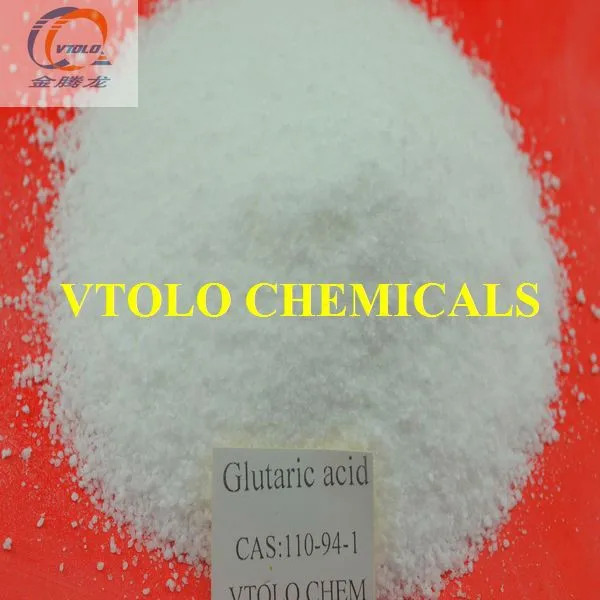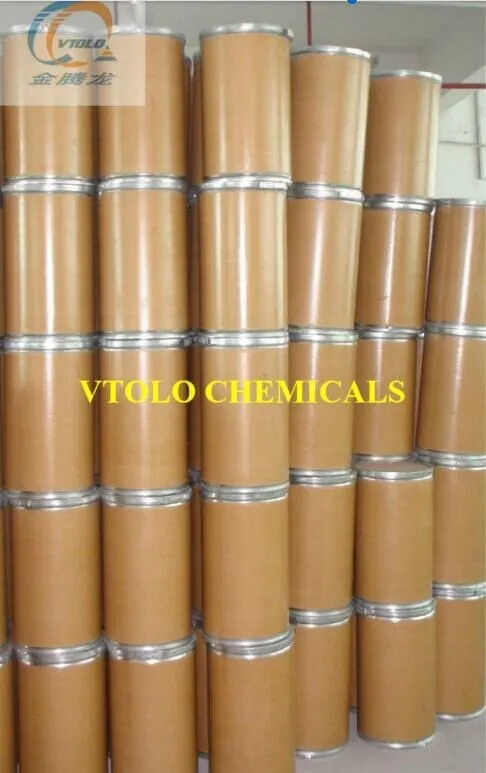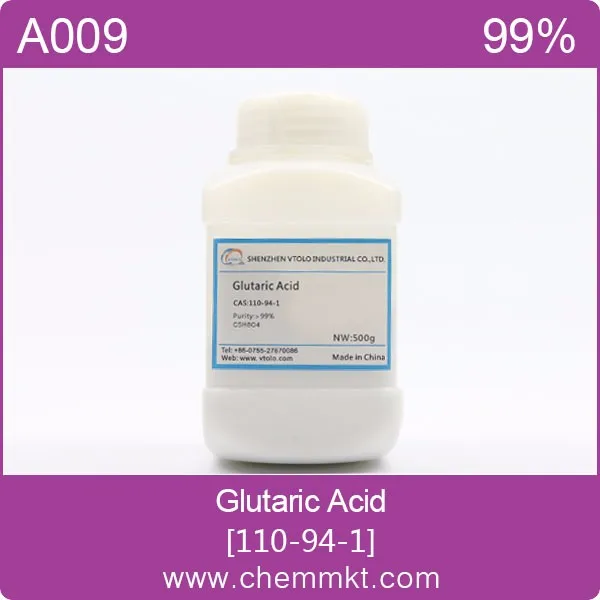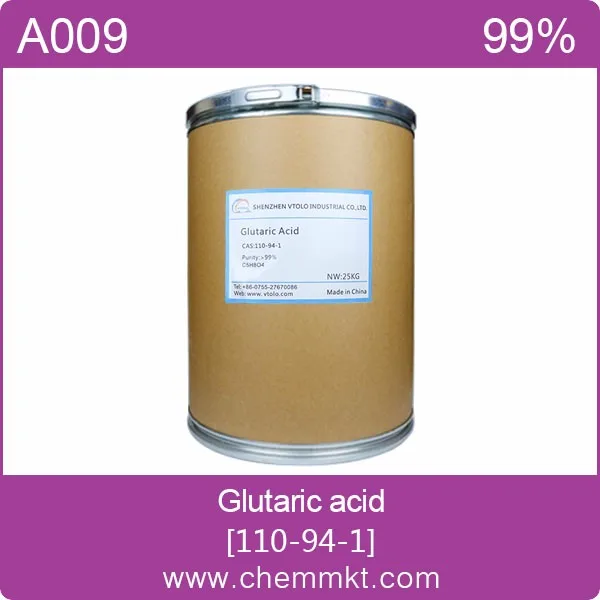Glutaric Acid 
Purity 99% Glutaric Acid 110-94-1
1.origin in China
2.CAS NO.110-94-1
3.Uses:raw material of Glutaric Anhydride
- Glutaric Acid basic information
Product Name:
Glutaric Acid
Synonyms:
a,-Propanedicarboxylicacid;glutaric;Glutarsaure;1,3-PROPANEDICARBOXYLIC ACID;1,5-PENTADIOIC ACID;1,5-PENTANEDIOIC ACID;GLUTARIC ACID AND ANHYDRIDE;GLUTARIC ACID
Product Categories:
Pharmaceutical Intermediates;alpha,omega-Alkanedicarboxylic Acids;alpha,omega-Bifunctional Alkanes;Monofunctional & alpha,omega-Bifunctional Alkanes;C1 to C5;Carbonyl Compounds;Carboxylic Acids
- Glutaric Acid chemical properties
Water Solubility :
430 g/L (20 ºC)
Stability:
Stable. Incompatible with bases, oxidizing agents, reducing agents.
CAS DataBase Reference:
110-94-1(CAS DataBase Reference)
NIST Chemistry Reference:
Pentanedioic acid(110-94-1)
EPA Substance Registry System:
Pentanedioic acid(110-94-1)
- Glutaric Acid usage and synthesis
Chemical Properties:
white or off-white crystals
General Description:
Colorless crystals or white solid.
Air & Water Reactions:
Water soluble.
Reactivity Profile:
1,5-Pentanedioic acid is a carboxylic acid. Carboxylic acids donate hydrogen ions if a base is present to accept them. They react in this way with all bases, both organic (for example, the amines) and inorganic. Their reactions with bases, called "neutralizations", are accompanied by the evolution of substantial amounts of heat. Neutralization between an acid and a base produces water plus a salt. Carboxylic acids with six or fewer carbon atoms are freely or moderately soluble in water; those with more than six carbons are slightly soluble in water. Soluble carboxylic acid dissociate to an extent in water to yield hydrogen ions. The pH of solutions of carboxylic acids is therefore less than 7.0. Many insoluble carboxylic acids react rapidly with aqueous solutions containing a chemical base and dissolve as the neutralization generates a soluble salt. Carboxylic acids in aqueous solution and liquid or molten carboxylic acids can react with active metals to form gaseous hydrogen and a metal salt. Such reactions occur in principle for solid carboxylic acids as well, but are slow if the solid acid remains dry. Even "insoluble" carboxylic acids may absorb enough water from the air and dissolve sufficiently in 1,5-Pentanedioic acid to corrode or dissolve iron, steel, and aluminum parts and containers. Carboxylic acids, like other acids, react with cyanide salts to generate gaseous hydrogen cyanide. The reaction is slower for dry, solid carboxylic acids. Insoluble carboxylic acids react with solutions of cyanides to cause the release of gaseous hydrogen cyanide. Flammable and/or toxic gases and heat are generated by the reaction of carboxylic acids with diazo compounds, dithiocarbamates, isocyanates, mercaptans, nitrides, and sulfides. Carboxylic acids, especially in aqueous solution, also react with sulfites, nitrites, thiosulfates (to give H2S and SO3), dithionites (SO2), to generate flammable and/or toxic gases and heat. Their reaction with carbonates and bicarbonates generates a harmless gas (carbon dioxide) but still heat. Like other organic compounds, carboxylic acids can be oxidized by strong oxidizing agents and reduced by strong reducing agents. These reactions generate heat. A wide variety of products is possible. Like other acids, carboxylic acids may initiate polymerization reactions; like other acids, they often catalyze (increase the rate of) chemical reactions 1,5-Pentanedioic acid reacts with bases, oxidizing agents and reducing agents.
Fire Hazard:
Flash point data for 1,5-Pentanedioic acid are not available; however, 1,5-Pentanedioic acid is probably combustible.
- Glutaric Acid Preparation Products And Raw materials
Preparation Products:
Buspirone-->Cinmethylin-->Glutaric anhydride-->Azelaic acid-->LACCAIC ACID-->Baclofen
Raw materials:
Nitric acid-->Ammonium chloride -->POTASSIUM CYANIDE-->Cyclohexanone-->Paraffin wax-->Adipic acid-->Cyclopentanone-->gamma-Butyrolactone-->1,3-Propanediol-->NITROGEN DIOXIDE-->2,3-Dihydrofuran-->Glutaronitrile-->oxidized paraffin(wax)
25kg/PP woven bag with PE liner inside




Organic Acid
A001 2,2’-Bis(hydroxymethyl)butyric acid 10097-02-6
A002 2,2-Dimethylol Propionic Acid 4767-03-7
A003 succinic acid 110-15-6
A004 sebacic acid 111-20-6
A005 2,3-Dibromosuccinic acid 526-78-3
A006 adipic acid 124-04-9
A007 Itaconic acid 97-65-4
A008 Octanedioic acid / Suberic acid 505-48-6
A009 Glutaric acid 110-94-1
A010 Pimelic acid 111-16-0
A011 Azelaic acid 123-99-9
A012 Azelaic acid 123-99-9
A013 Malonic acid 141-82-2
A014 methylsuccinic acid 498-21-5
A015 Phenyl succinic acid 635-51-8
A016 Dodecandioic acid (DDA) 693-23-2
A017 Glycolic acid 79-14-1
A018 Dicarboxylic acid mixture 68603-87-2
A019 Salicylic acid 69-72-7
A020 maleic acid 110-16-7
A021 O-Phthalic acid 88-99-3
A022 2-Iodobenzoic Acid 88-67-5
A023 2-Picolinic acid 98-98-6
A024 Tert-Butyl benzoic acid 98-73-7
A025 DL-Malic acid 617-48-1
A026 L-Glutamic acid 56-86-0
A027 Aminoacetic aicd 56-40-6
A028 2-Decyltetradecanoicacid 93778-52-0
A029 L-lactic acid 50-21-5
A030 Fumaric acid 110-17-8
A031 5-Chlorosalicylic acid 321-14-2
A032 Himic anhydride 826-62-0
A033 Chlorendicanhydribe 115-27-5
A034 Succinic Anhydride 108-30-5
A035 Glutaric anhydride 108-55-4
A036 2-Furoic acid 88-14-2
關(guān)鍵字: Glutaric Acid;110-94-1
Vtolo is specializing in producing and selling many kinds of intermediates, solvents and additives, using in Flux, Solder paste, Solder wire, Water-based coating paint, ink, building materials, Adhesives, binders, sealants and Cosmetics products' manufacture.
If interested in the chemicals series below,
please contact me by email
1. Organic acid (DMBA10097-02-6, DMPA4767-03-7);
2. Organic Solvent;
3. Rosin;
4. Amine Halogen;
5. Imidazole;
6. Cationic Surfactant.